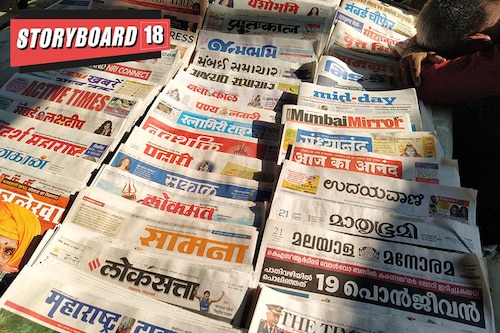How the Indian newspaper industry sees the impact of a newsprint price drop
Newsprint supply from Russia has also gained momentum after disruptions in shipping lines due to the EU and US sanctions, as per industry sources


The newspaper industry is gradually approaching pre-COVID business figures. The first half of this year has witnessed nearly a 5 percent year-on-year increase in ad space, and now newsprint prices have started to decline, leading to hopes of improved profit margins and a full recovery in the upcoming quarters.
According to an official spokesperson from the Dainik Bhaskar newspaper group, newsprint costs account for approximately 45 percent of the total expenses, including all overheads. “Consequently, any reduction in newsprint prices is poised to lower the overall cost structure, positively impacting EBIDTA (earnings before interest, taxes, depreciation). Moreover, publishers are now more inclined to increase page counts to accommodate advertisements, further augmenting revenue, thanks to the reduced newsprint prices," the spokesperson said.
Before the onset of the Covid pandemic, imported newsprint prices stood at approximately $400 per metric tonne. However, in the aftermath of the pandemic, as businesses began to recover, disruptions in the supply chain drove newsprint prices up significantly, reaching a peak of $1,000-1,050 per metric tonne.
In the first quarter of the fiscal year 2022-23, imported newsprint rates started dropping, eventually reaching around $600 per metric tonne in the last quarter. Recent discussions point towards a range of $540-560 per metric tonne for the third quarter of fiscal year 2023-24.
Currently, imported newsprint prices are hovering around $530 per metric tonne.
Similarly, before the pandemic, indigenous newsprint prices varied from Rs 31 to Rs 35 per kilogram, depending on quality.
However, during the Covid crisis, these prices also surged, exceeding Rs 70 per kilogram. In the first quarter of the fiscal year 2022-23, indigenous newsprint rates began to decline, and by July 2023, they had fallen to the range of Rs 48 to Rs 52 per kilogram, again depending on quality.
Several factors have contributed to the decline in newsprint rates. Firstly, the gradual re-establishment of the supply chain, which had been disrupted during the pandemic, has played a significant role.
Secondly, there is a global decrease in newsprint demand, including in India, possibly due to publishers carrying high inventory levels worldwide. Additionally, the reduction in input costs, such as raw materials and crude oil, has also influenced the pricing. The decrease in marine freight costs can be attributed to the re-establishment of the global import container movement cycle.
As per sources, newsprint supply from Russia has gained momentum after disruptions caused by the withdrawal of major shipping lines from Russia following European and US sanctions in the aftermath of the Russia-Ukraine conflict.
Lastly, some domestic newsprint mills, which previously turned to brown paper and refined waste production for export to Chinese newsprint mills, have shifted their focus back to newsprint production. India also saw the addition of two large newsprint mills, NEPA Ltd in central India with a daily production capacity of 300 metric tonne and Kerala Paper Product Ltd in Southern India with a capacity of 300 metric tonne daily.
According to Mohit Jain, board member and executive director at Bennett Coleman & Co Ltd, despite newsprint prices reaching over $900 per metric tonne last year, there was no increase in ad spending by companies. This lack of growth resulted in significant losses. Evidently, the drop in newsprint price is not showing an immediate impact but helping in recovery, he said.
“With the current decrease in newsprint prices, there is an opportunity to offset some of the losses made last year," he said.
“Newspapers stock newsprint well in advance, so given the substantial inventory of high-cost newsprint that companies currently hold, the full impact on production costs is expected to become evident starting next year," Jain said.
Also, the depreciation of the Indian rupee by close to 15 percent has had a lasting effect on publishers, leading to a significant and permanent increase in their costs, even in the face of reduced newsprint prices.
Mathrubhumi Group’s Managing Director Shreyams Kumar echoed Jain’s perspective on surplus newsprint that print publications are sitting on.
According to Kumar, the price drop is also a mere correction. “Newsprint prices have finally returned to more reasonable levels," he said. Moreover, according to him, while newsprint constitutes a significant portion of production costs, rising wages and other raw material expenses are offsetting any substantial relief. However, Kumar is also looking at a better EBIDTA soon. “The overall outlook suggests a more favourable scenario for the industry," he said.
First Published: Sep 12, 2023, 17:18
Subscribe Now